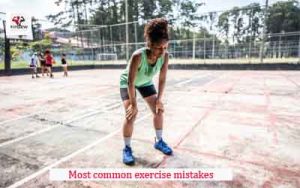While exercising is good and also helps you live a healthy life, there are exercise mistakes you should not make.
This content is about the most common exercise mistakes. Read to the last dot to get all the details you need.

Most common exercise mistakes
Here are the most common exercise mistakes
- Skipping of warm-up exercises: According to what Austin Johnson, a San Antonio, Texas-based NCSF certified personal trainer and national personal training manager for Gold’s Gym said which is starting any workout with cold muscles is a terrible idea, and makes you very vulnerable to injury.
Warmups get the blood flowing, enhances body and muscle temperature, as well as improves muscle elasticity and this assist you in avoiding injuring cold muscles.
For the fact you need to warm up does not mean you will engage in any warm up exercise. you are to engage in warm ups that suits the workout you are to carry out next.
If for instance your workout is focused on squats, your warm-up should be with hip-opening dynamic stretches like forward bends and jumping jacks. These moves lead to increase in blood flow to the lower extremities as well as get your body ready for the movement patterns in your workout.
- Bypassing the cooldown: Just like you are supposed to engage in warm up exercises before the main workout, so also you are to engage in cooldown exercises like static stretching that involves the muscle groups you worked on.
Cooldown exercises starts the recovery and can as well assist in the removal of lactic acid from your muscles. Lactic acid is a byproduct from exercise which can result to increase in post-workout soreness.
After a lower-body workout, you can engage in static moves like the hamstring stretch or the hip-flexor stretch. You can do this for 5 to 10 minutes and finish with a few minutes of foam rolling for extra credit.
- Lack of a game plan: Having a game plan is very important if you must achieve your goals in the gym. With game plan, you will be focused on reaching your fitness goals.
For instance, if your plan is to master the push-up, you will ensure you add strength training to your workout sessions to get the results you need. When exercising, ensure to target your arms, chest, shoulders, and core.
- Ignoring the right form for exercise: After setting your fitness goals, the next thing is to work out the plans and actualize them. While you might be excited to be carrying out the exercise, don’t allow the excitement make you not to focus on the right exercise form. Loosing focus on the right exercise form might result to injury as well as cause delays in your reaching your fitness goals.
From a study carried out by researchers on shoulder injuries among people who do high-intensity training, improper form was one of the most common causes of injury.
So, having the knowledge of how to carry out each exercise in your routine rightly is essential. Starting out slowly and allowing time to understand the right technique is one of the ways you can learn the right form of carrying out the exercises.

- Thinking about exercise as a chore: The process involved in your fitness journey is gradual. When you select workouts that you don’t like, it will make the process slower as well as difficult. Seeing it as a chore can even make you stop exercising completely.
Any time you feel like skipping your workouts it might be a sign that you need to try a new thing. According to research, pleasure is a crucial part of forming habits. That is to say that when you are involved in exercises you like, you will have the motivation to keep up with them.
- Doing the same thing every single workout or switching things up too often: When you find a workout you like, no matter how tempting it will be for you to stick to it, ensure you change your workout routine to avoid boredom and also ensure you progress towards reaching your fitness goals.
And don’t try switching things up too often, instead gradually enhance the intensity, frequency, or duration of exercises. Progressive training may be a better procedure to achieve gain more endurance, and strength, as well as reach your other fitness goals.
- When you forget about hydration: Water makes up more than half of your weight. Your body needs enough water to function. According to research, losing more than 2% of the water in your body can result in dehydration which may affect your exercise performance in some conditions.
It is very important for you to replenish the fluids you lose in the form of sweat while you are exercising. Hydration may be different based on age, weight, and activity level. Your being thirsty can be a great guide to assist you in staying hydrated. Always listen to your body to know when you need to take water.
If you are still not sure the quantity of water that is adequate for you to take, check out what the American Council on Exercise suggests for you:
Drink 17 to 20 oz of water 2 to 3 hours before you start exercise.
Drink 8 oz 20 to 30 minutes before you start the exercise.
Drink 7 to 10 oz every 10 to 20 minutes during the exercise.
Drink 8 oz 30 minutes after the exercise.
- Trying to do too much too soon: Overexertion happens when you push yourself too hard. For example, when you add 20 lbs more than you can safely lift on a bench press, that might be you overexerting.
Here are some signs of overexertion
- Unusual or persistent muscle soreness after your workout
- Delay in recovery after exercise
- Declines in Performance or plateaus
- Extended fatigue
- Low energy or moodiness
- Irregular menstrual cycles
- Extreme weight and appetite loss
Recovering from overtraining is different for everyone. Getting adequate sleep, eating a nutritious diet, and taking time off can assist athletes in recovering from overtraining.
Strategies that assist you in avoiding other workout mistakes like proper exercise form as well as progressive training can also assist you in avoiding overexertion.
- Overlooking the importance of rest: Muscle soreness can be a sign that your muscles are still recuperating after exercise. The pain you feel happens as your muscles get used to training.
Procedures like icing your muscles as well as practicing active recovery can assist with delayed-onset muscle soreness. You can practice active recovery while engaging in low-intensity workouts like walking, swimming, or stretching.
The number of rest and recovery days you need is dependent on the intensity of the exercise. Research suggests that roughly 48 to 72 hours of rest may be best for the repair of muscles. That is to say, you should allow at least 2 days a week for recovery before working the same group of muscles.
Conclusion
When you avoid these common exercise mistakes, you will be able to improve your workout results as well as avoid injuries.
Have these workout mistakes in mind so you will be able to avoid them at all times. Also, you can discuss with a personal trainer if you have any additional questions on how you can exercise safely as well as efficiently, and with joy.
Editor’s pick
10 Best Gym Exercises for Stress Relief and Relaxation (A must read for everyone)
10 dangerous exercises to avoid in your workouts (A must read for everyone)
no prescription online prednisone